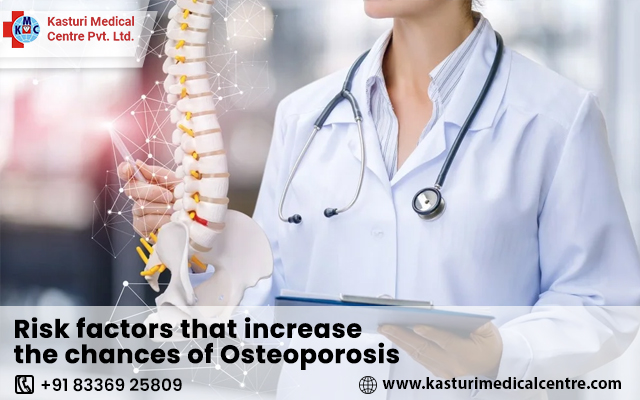Osteoporosis results in weakened and brittle bones, making them susceptible to fractures from minor stresses like bending over, stumbling, or even a simple fall. In people with osteoporosis, the bones become so fragile that even a simple cough or sneeze can result in a fracture. Though this condition usually affects individuals irrespective of their gender, postmenopausal women are particularly vulnerable. Below, the best orthopedician in South Kolkata has outlined the risk factors that increase the chances of developing Osteoporosis.
Risk factors of Osteoporosis
There are innumerable factors that can heighten the risk of Osteoporosis, including age, bone density, medical conditions, and one’s poor lifestyle choices. Get to know more about them below.
1. Hormone levels: People who have either excess or deficiency of specific hormones are more likely to develop Osteoporosis. Examples include:
- Sex hormones: A significant risk factor for Osteoporosis is the decline in estrogen levels during menopause in women. Men who suffer from prostate cancer experience a decrease in their testosterone levels, which accelerates bone loss. These hormones have an important role to play in regulating bone strength. Reduced levels of these hormones can cause them to become weak.
- Thyroid problems: An excess of thyroid hormone leads to bone loss. This might happen due to an overactive thyroid gland or an increased use of thyroid hormone medication to address an underactive thyroid gland.
2. Dietary factors: Inadequate intake of essential nutrients that are needed for maintaining bone strength can escalate the probability of developing Osteoporosis. For instance, insufficient calcium intake throughout one’s life is associated with reduced bone density, premature bone loss, and an elevated risk of fractures.
Top orthopedicians of the best hospital in South Kolkata advise individuals who are around twenty to fifty years old to consume a recommended amount of 1000 mg of calcium and 600 units of Vitamin D daily. This can be met by including calcium-rich foods, such as figs and apricots, green leafy vegetables and fish. The best sources of Vitamin D include sunlight, and nutritious food items like milk, almonds, and mushrooms.
3. Low body weight: A lower body weight often leads to the deterioration of bone tissues. In older individuals, there is also less fat around the hips, which increases the possibility of fractures.
4. Smoking: The process of bone-building is hindered by smoking. For women, smoking is additionally linked to higher odds of experiencing early menopause. Postmenopausal women, already at a heightened risk of bone fractures, face increased susceptibility due to smoking.
5. Excessive alcohol consumption: The cells responsible for bone formation are negatively affected by alcohol consumption. It also impairs balance, making alcoholic people more prone to falls.
6. People who have undergone bariatric surgery: Emerging evidence indicates that this surgery causes an increased deficiency of calcium and vitamin D, leading to subsequent osteoporosis.
7. People who take oral corticosteroids regularly: The intake of corticosteroids reduces the body’s capacity to absorb calcium and facilitates bone loss.
8. Health disorders: People who suffer from certain health conditions like Inflammatory Bowel Disease, Rheumatoid Arthritis, kidney failure, liver disease, or an eating disorder are highly likely to suffer from osteoporosis.
If you experience severe discomfort in your spinal vertebrae, wrists or hips, it can be an indication of broken bones. In that case, you must seek expert guidance from the best orthopedician in South Kolkata for immediate diagnosis and treatment.

